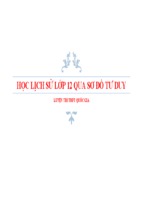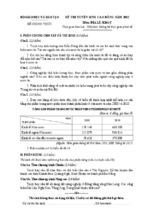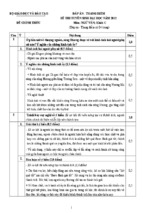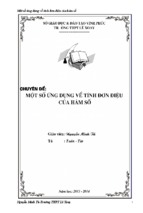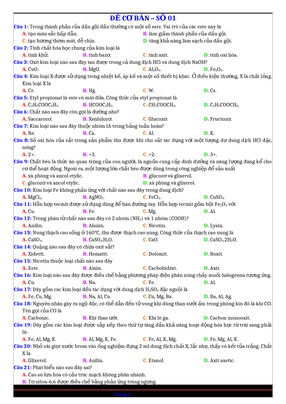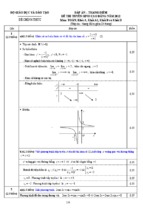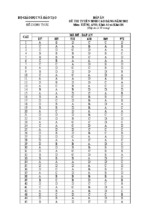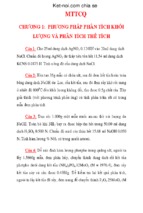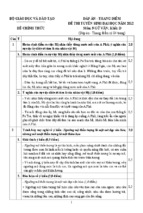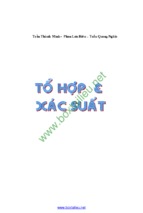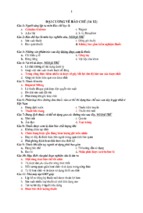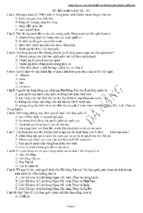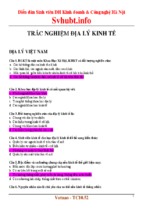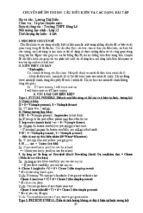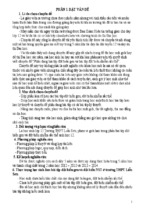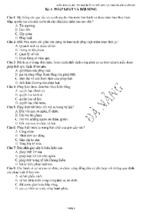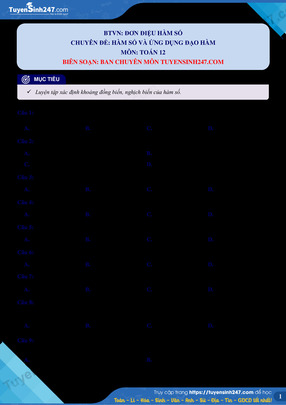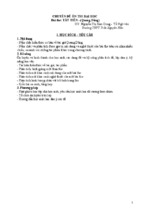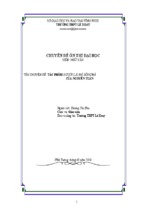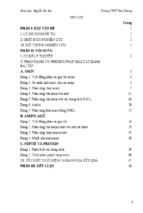Luyện đề thi THPT QG 2017 môn tiếng Anh (Đề thi thử số 14) |
[email protected] (Biên soạn)
BỘ GIÁO DỤC VÀ ĐÀO TẠO
ĐỀ THI THỬ KỲ THI THPT QUỐC GIA 2017
ĐỀ THI THỬ SỐ 14
Môn: TIẾNG ANH
(Đề thi gồm có 6 trang – 50 câu)
Thời gian làm bài: 60 phút, không kể thời gian phát đề
Mã đề thi 157
Fanpage Ngân hàng bài tập tiếng Anh theo chuyên đề
Họ, tên thí sinh:...................................................................................... Số báo danh: .........................
MULTIPLE CHOICE
Mark the letter A, B, C, or D on your answer sheet to indicate the word whose underlined
part differs from the other three in pronunciation in each of the following questions.
Question 1: A. exhibition
Question 2: A. ceased
B. ignite
B. decreased
C. vintage
C. released
D. vineyard
D. teased
Mark the letter A, B, C, or D on your answer sheet to indicate the word that differs from
the other three in the position of primary stress in each of the following questions.
Question 3: A. environment
Question 4: A. redundant
B. political
B. descendant
C. eradicate
C. relevant
D. centenarian
D. consultant
Mark the letter A, B, C, or D on your answer sheet to indicate the underlined part that
needs correction in each of the following questions.
Question 5: Higher education is very importance to national economies, and it is also a source of
trained and educated personnel for the whole country.
A. economies
B. the whole country C. importance
D. educated
Question 6: It was suggested that Pedro studies the material more thoroughly before attempting to
pass the exam.
A. studies
B. attempting
C. to
D. pass
Question 7: The little boy’s mother bought him a five-speeds racing bicycle for his birthday.
A. for his
B. five-speeds
C. The little
D. bought him
Mark the letter A, B, C, or D on your answer sheet to indicate the correct answer to each
of the following questions.
Question 8: Out ______ when the bell rang.
A. run the children
B. do the children run C. ran the children
D. did the children run
Question 9: The students don’t know how to do the exercise _____ by the teacher yesterday.
A. which written
B. is writing
C. who written
D. written
Question 10: Students are _____ less pressure as a result of changes in testing procedures.
A. out of
B. upon
C. under
D. above
Question 11: Cultural diversity supports the idea that every person can ______ a unique and
positive contribution to the larger society because of, rather than in spite of, their differences.
A. take
B. make
C. lead
D. pay
Question 12: It is imperative that the world _____ towards a solution to global warming before the
weather patterns of the world are disrupted irreparably.
A. work
B. to work
C. works
D. is working
Trang 1/6 – Mã đề thi 157
Luyện đề thi THPT QG 2017 môn tiếng Anh (Đề thi thử số 14) |
[email protected] (Biên soạn)
Question 13: _____ man suffering from _____ shock should not be given anything to drink.
A. A/ the
B. The/ a
C. Ø/ a
D. A/ Ø
Question 14: That cannot be a true story. He _____ it up.
A. must have made
B. can have made
C. should have made
D. would have made
Question 15: Hai Phong wanted to welcome the New Year by building a _____ dragon statue in its
city centre. However, the city didn’t realize the statue would welcome the Pokemon Go playing
masses.
A. flowerless
B. flowers
C. flowerity
D. flowery
Question 16: I really must go and lie down for a while. I’ve got a _____ headache!
A. cutting
B. splitting
C. ringing
D. burning
Question 17: The police paid no attention to Clare’s complaint because she _____ them so many
times before.
A. phoned
B. has phoned
C. had phoned
D. was phoning
Question 18: Steve _____ his chances of passing by spending too much time on the first question.
A. threw out
B. threw away
C. threw off
D. threw in
Question 19: Even if you are rich, you should save some money for a _____ day.
A. rainy
B. windy
C. foggy
D. snowy
Mark the letter A, B, C, or D on your answer sheet to indicate the most suitable response
to complete each of the following exchanges.
Question 20: Jack saw Marry in her new dress at the party.
- Jack: “_____”
- Marry: “Thank you for your compliment.”
A. You’ve done very well
B. This is a present for you
C. You look pretty in this dress
D. I’m glad that you’re well again
Question 21: Lan and Mai was taking about their study at school.
- Mai: “I thought your English skill was a lot better, Lan.”
- Lan: “_____”
A. Thank you. I’d love to.
B. Yes, please. Just a little.
C. No, thanks. I think I can do it.
D. You’ve got to be kidding. I thought it was bad
Mark the letter A, B, C, or D on your answer sheet to indicate the word or phrase that is
CLOSEST in meaning to the underlined part in each of the following questions.
Question 22: The dim appearance of the Milky Way results from the combined light of stars too far
away to be seen with the naked eye.
A. faint
B. unique
C. immense
D. curious
Question 23: I’d rather stay in a hotel with all the amenities than camp in the woods.
A. friends
B. conveniences
C. expenses
D. sports
Mark the letter A, B, C, or D on your answer sheet to indicate the word that is OPPOSITE
in meaning to the underlined part in each of the following questions.
Question 24: Mr. Smith’s new neighbors appear to be very friendly.
A. amicable
B. inapplicable
C. hostile
D. futile
Trang 2/6 – Mã đề thi 157
Luyện đề thi THPT QG 2017 môn tiếng Anh (Đề thi thử số 14) |
[email protected] (Biên soạn)
Question 25: TPOTY is one of the world's most prestigious photography awards, receiving entries
from nearly 100 countries annually.
A. distinguished
B. famed
C. renowned
D. ordinary
Mark the letter A, B, C, or D on your answer sheet to indicate the sentence that is closest
in meaning to each of the following questions.
Question 26: “Don’t forget to tidy up the final draft before submission,” the team leader told us.
A. The team leader asked us to tidy up the final draft before submission.
B. The team leader reminded us to tidy up the final draft before submission.
C. The team leader ordered us to tidy up the final draft before submission.
D. The team leader simply wanted us to tidy up the final draft before submission.
Question 27: The president offered his congratulations to the players when they won the cup.
A. The President congratulated the players on their winning the match.
B. When they won the cup, the players had been offered some congratulations from the
President.
C. The President congratulated that the players had won the cup.
D. The President would offered the players congratulations if they won the match.
Question 28: My decision to get up and dance coincided with the band’s decision to stop playing.
A. The moment I decided to get up and dance, the band decided to stop playing.
B. As soon as I got up and danced, the band stopped playing.
C. When I was dancing, the band stopped playing.
D. I danced until the band stopped playing.
Mark the letter A, B, C, or D on your answer sheet to indicate the sentence that best
combines each pair of sentences in the following questions.
Question 29: Her living conditions were not good. However, she studied very well.
A. Living in difficult conditions forced she to study very well.
B. She studied very well just because she lived in difficult conditions.
C. Difficult as her living conditions were, she studied very well.
D. Living in difficult conditions, she had no choice but to study well.
Question 30: I think my hair looks fine. My mother believes it needs a little more brushing.
A. Not only do I think my hair looks fine, but my mother also believes it needs a little more
brushing.
B. Either my mother believes it needs a little more brushing or I think my hair looks fine.
C. I think my hair looks so fine that my mother believes it needs a little more brushing.
D. I think my hair looks fine, but my mother believes it needs a little more brushing.
Read the following passage and mark the letter A, B, C, or D on your answer sheet to
indicate the correct word or phrase that best fits each of the numbered blanks.
The growth of population has its problems as we shall see. As there are more and more mouths
(31)_____, there comes a great strain (32)_____ the resources of a country; this is real in the case of
developing countries with the result they are unable to push ahead economically. As food is not
sufficient there is chronic malnutrition in these countries especially in women and children resulting in
weaker population (33)_____ would only economically be a drain on the country as their productive
years will be short. As health and education are the State's (34)_____, they affect the country's
finances. So in developing countries health and illiteracy continue to be the problem. The unwieldy
growth of population leads to the problem of housing and sanitation. In many countries the slums are
a (35)_____ to the eyes. Slums grow round big cities and are found with all the drawbacks. These are
the areas of disease, filth and crime.
(Adapted from: The problem of over population)
Trang 3/6 – Mã đề thi 157
Luyện đề thi THPT QG 2017 môn tiếng Anh (Đề thi thử số 14) |
[email protected] (Biên soạn)
Question 31:
Question 32:
Question 33:
Question 34:
Question 35:
A. to be fed
A. to
A. which
A. problem
A. pain
B. to feed
B. for
B. what
B. job
B. sore
C. for feeding
C. down
C. who
C. affair
C. hurt
D. fed
D. on
D. those
D. work
D. wound
Read the following passage and mark the letter A, B, C, or D on your answer sheet to
indicate the correct answer to each of the questions from 36 to 42.
Global emissions of carbon dioxide from fossil fuel burning jumped by the largest amount on
record in 2010. Emissions rose 5.9 percent in 2010, according to an analysis released on Sunday by
the Global Carbon Project.
Scientists said the increase was almost certainly the largest absolute jump in any year since
the Industrial Revolution. The increase solidified a trend of ever-rising emissions that will make it
difficult, if not impossible, to stop severe climate change in coming decades.
The burning of coal represented more than half of the growth in emissions, the analysis found.
In the United States, emissions dropped by a remarkable 7 percent in the year of 2009, but rose by
over 4 percent in 2010, the new analysis shows.
“Each year, emissions go up, and there’s another year of negotiations, another year of
indecision,” said Glen P. Peters, a researcher at the Center for International Climate and
Environmental Research. “There’s no evidence that this path we’ve been following in the last 10 years
is going to change.”
Scientists say the rapid growth of emissions is warming the Earth and putting human welfare
at long-term risk. But their increasingly urgent pleas that society find a way to limit emissions have
met sharp political resistance in many countries because doing so would involve higher energy costs.
The new figures show a continuation of a trend in which developing countries have surpassed
the wealthy countries in their overall greenhouse emissions. In 2010, the burning of fossil fuels and
the production of cement sent more than nine billion tons of carbon into the atmosphere, the new
analysis found, with 57 percent of that coming from developing countries.
On the surface, the figures of recent years suggest that wealthy countries have made
headway in stabilizing their emissions. But Dr. Peters pointed out that, in a sense, the rich countries
have simply exported some of them.
The fast rise in developing countries has been caused to a large extent by the growth of
energy-intensive manufacturing industries that make goods that rich countries import. “All that has
changed is the location in which the emissions are being produced,” Dr. Peters said.
Many countries, as part of their response to the economic crisis, invested billions in programs
designed to make their energy systems greener. While it is possible, the new numbers suggest they
have had little effect so far.
(Source: www.nytimes.com)
Question 36: Many governments in the world resist limiting emissions because _____.
A. it is not the best way to solve such problems
B. they don’t realize the risks of carbon emissions
C. it would probably harm human welfare in the long run
D. they are unwilling to accept higher energy costs
Question 37: According to the passage, the report found that the burning coal accounts for _____ of
the increase in total emissions.
A. more than half
B. one-third
C. only about 7 percent
D. over 4 percent
Trang 4/6 – Mã đề thi 157
Luyện đề thi THPT QG 2017 môn tiếng Anh (Đề thi thử số 14) |
[email protected] (Biên soạn)
Question 38: According to Glen P. Peters, we can learn that _____.
A. the rapid growth of emissions contributes to potential risks for humans
B. rich countries actually take more responsibility for the growth of emissions
C. human beings will follow the same path of negotiations in the next 10 years
D. some countries negotiate together yearly whether to reduce the amounts of emissions
Question 39: The word “urgent” in the passage is closest in meaning to _____.
A. needful
B. pressing
C. related
D. unsolved
Question 40: Which of the following is TRUE according to the text?
A. Emissions in the United States dropped by about 7 percent in 2010.
B. Developing countries will produce less emissions with economic development.
C. There is a long way to go for many countries to limit the fast growth of emissions.
D. Over 50 percent of the growth in emissions resulted from the burning of fossil fuels.
Question 41: The phrase “On the surface” in the seventh paragraph means most nearly the same
as _____.
A. Not thought about deeply or thoroughly
B. Just the tip of the iceberg
C. Judging from what can be seen
D. To all intents and purposes
Question 42: What is the main idea of this passage?
A. an analysis released by the Global Carbon Project
B. the record jump in carbon dioxide emissions
C. the possible climate change in future decades
D. the main harm of greenhouse gases
Read the following passage and mark the letter A, B, C, or D on your answer sheet to
indicate the correct answer to each of the questions from 43 to 50.
An air pollutant is defined as a compound added directly or indirectly by humans to the
atmosphere in such quantities as to affect humans, animals, vegetation, or materials adversely. Air
pollution requires a very flexible definition that permits continuous changes. When the first air
pollution laws were established in England in the fourteenth century, air pollutants were limited to
compounds that could be seen or smelled- a far cry from the extensive list of harmful substances
known today. As technology has developed and knowledge of health aspects of various chemicals has
increased, the list of air pollutants has lengthened. In the future, even water vapor might be
considered an air pollutant under certain conditions.
Many of more important air pollutants, such as sulfur oxides, carbon monoxides and nitrogen
oxides are found in nature. As the Earth developed, the concentration of these pollutants was altered
by various chemical reactions; they became components in biogeochemical cycles. These serve as an
air purification scheme by allowing the compounds to move from the air to the water or soil. On a
global basis, nature's output of these compounds dwarfs that resulting from human activities.
However, human production usually occurs in a localized area, such as a city. In such region,
human output may be dominant and may temporarily overload the natural purification scheme of the
cycles. The result is an concentration of noxious chemicals in the air. The concentrations at which
the adverse effects appear will be greater than the concentrations that the pollutants would have in
the absence of human activities. The actual concentration need not be large for a substance to be a
pollutant; in fact, the numerical value tells us little until we know how much of an increase this
represents over the concentration that would occur naturally in the area. For example, sulfur dioxide
has detectable health effects at 0.08 parts per million (ppm), which is about 400 times its natural
Trang 5/6 – Mã đề thi 157
Luyện đề thi THPT QG 2017 môn tiếng Anh (Đề thi thử số 14) |
[email protected] (Biên soạn)
level. Carbon monoxide, however has a natural level of 0.1 ppm and is not usually a pollutant until its
level reaches about 15 ppm.
Question 43: What does the passage mainly discuss?
A. The effects of compounds added to the atmosphere
B. The economic impact of air pollution
C. What constitutes an air pollutant
D. How much harm air pollutants can cause
Question 44: The word “adversely” is closest in meaning to _____.
A. considerably
B. quickly
C. admittedly
D. negatively
Question 45: It can be inferred from the first paragraph that _____.
A. the definition of air pollution will continue to change.
B. water vapor is an air pollutant in localized areas.
C. most pollutants today can be seen or smelled.
D. a substance becomes an air pollutant only in cities.
Question 46: The word “These” in the second paragraph refers to _____.
A. the compounds moved to the water or soil
B. the various chemical reactions
C. the pollutants from the developing Earth
D. the components in biogeochemical cycles
Question 47: According to the passage, human-generated air pollution in localized regions _____.
A. will react harmfully with natural pollutants.
B. can overwhelm the natural system removing pollutants.
C. will damage area outside of the localized regions.
D. can be dwarfed by nature's output of pollutants.
Question 48: The word “noxious” is closest in meaning to _____.
A. harmful
B. noticeable
C. extensive
D. weak
Question 49: According to the passage, the numerical value of the concentration level of a
substance is only useful if _____.
A. the other substances in the area are known B. it can be calculated quickly
C. it is in a localized area
D. the natural level is also known
Question 50: For which of the following reasons can natural pollutants play an important role in
controlling air pollution?
A. They have existed since the Earth developed.
B. They occur in greater quantities than other pollutants.
C. They're less harmful to living beings than other pollutants.
D. They function as part of a purification process.
______THE END______
Trang 6/6 – Mã đề thi 157


